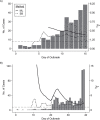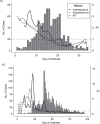Statistical Estimation of the Reproductive Number From Case Notification Data
- PMID: 33034345
- PMCID: PMC8244992
- DOI: 10.1093/aje/kwaa211
Statistical Estimation of the Reproductive Number From Case Notification Data
Abstract
The reproductive number, or reproduction number, is a valuable metric in understanding infectious disease dynamics. There is a large body of literature related to its use and estimation. In the last 15 years, there has been tremendous progress in statistically estimating this number using case notification data. These approaches are appealing because they are relevant in an ongoing outbreak (e.g., for assessing the effectiveness of interventions) and do not require substantial modeling expertise to be implemented. In this article, we describe these methods and the extensions that have been developed. We provide insight into the distinct interpretations of the estimators proposed and provide real data examples to illustrate how they are implemented. Finally, we conclude with a discussion of available software and opportunities for future development.
Keywords: infectious disease outbreaks; reproduction number; reproductive number; serial interval.
© The Author(s) 2020. Published by Oxford University Press on behalf of the Johns Hopkins Bloomberg School of Public Health. All rights reserved. For permissions, please e-mail: journals.permissions@oup.com.
Figures


Similar articles
-
Joint estimation of the basic reproduction number and generation time parameters for infectious disease outbreaks.Biostatistics. 2011 Apr;12(2):303-12. doi: 10.1093/biostatistics/kxq058. Epub 2010 Sep 21. Biostatistics. 2011. PMID: 20858771
-
The R0 package: a toolbox to estimate reproduction numbers for epidemic outbreaks.BMC Med Inform Decis Mak. 2012 Dec 18;12:147. doi: 10.1186/1472-6947-12-147. BMC Med Inform Decis Mak. 2012. PMID: 23249562 Free PMC article.
-
Bayesian estimation of the effective reproduction number for pandemic influenza A H1N1 in Guangdong Province, China.Ann Epidemiol. 2013 Jun;23(6):301-6. doi: 10.1016/j.annepidem.2013.04.005. Ann Epidemiol. 2013. PMID: 23683708
-
The impact of immunization control activities on measles outbreaks in middle and low income countries.Int J Epidemiol. 1997 Jun;26(3):662-9. doi: 10.1093/ije/26.3.662. Int J Epidemiol. 1997. PMID: 9222794 Review.
-
Deriving risk maps from epidemiological models of vector borne diseases: State-of-the-art and suggestions for best practice.Epidemics. 2020 Dec;33:100411. doi: 10.1016/j.epidem.2020.100411. Epub 2020 Oct 22. Epidemics. 2020. PMID: 33130413 Review.
Cited by
-
Why are different estimates of the effective reproductive number so different? A case study on COVID-19 in Germany.PLoS Comput Biol. 2023 Nov 27;19(11):e1011653. doi: 10.1371/journal.pcbi.1011653. eCollection 2023 Nov. PLoS Comput Biol. 2023. PMID: 38011276 Free PMC article.
-
Impact of intervention on the spread of COVID-19 in India: A model based study.J Theor Biol. 2021 Aug 21;523:110711. doi: 10.1016/j.jtbi.2021.110711. Epub 2021 Apr 20. J Theor Biol. 2021. PMID: 33862090 Free PMC article.
-
Extending the R number by applying hyperparameters of Log Gaussian Cox process models in an epidemiological context to provide insights into COVID-19 positivity in the City of Edinburgh and in students residing at Edinburgh University.PLoS One. 2023 Nov 21;18(11):e0291348. doi: 10.1371/journal.pone.0291348. eCollection 2023. PLoS One. 2023. PMID: 37988358 Free PMC article.
-
The risk of SARS-CoV-2 outbreaks in low prevalence settings following the removal of travel restrictions.Commun Med (Lond). 2021 Oct 15;1:39. doi: 10.1038/s43856-021-00038-8. eCollection 2021. Commun Med (Lond). 2021. PMID: 35602220 Free PMC article.
-
Estimating the basic reproduction number at the beginning of an outbreak.PLoS One. 2022 Jun 17;17(6):e0269306. doi: 10.1371/journal.pone.0269306. eCollection 2022. PLoS One. 2022. PMID: 35714080 Free PMC article.

